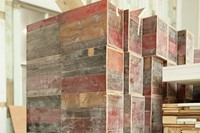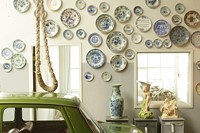Just in time for the abrupt advent of this year’s summery weather, venerable Champagne house Ruinart will be promoting their signature Blanc de Blanc and Rose wines in limited edition presentation boxes by Dutch designer Piet Hein Eek...
Just in time for the abrupt advent of this year’s summery weather, venerable Champagne house Ruinart will be promoting their signature Blanc de Blanc and Rose wines in limited edition presentation boxes by Dutch designer Piet Hein Eek. Founded in 1729, Ruinart is the oldest established Champagne house, and since 1895 when they first commissioned Czech Art Nouveau pioneer Alophonse Mucha to create a poster for them, have a longstanding tradition of pairing up with forward thinking artists and designers. Also a stalwart presence on the international art fair circuit, Ruinart will be setting up at no less than 18 fairs this year, including Art Basel, Fiac, and Masterpiece in London at the end of June, where the Piet Hein Eek box will be launched exclusively to attendees of the fair.
Known for producing one the finest Blanc de Blancs, a Champagne produced only from Chardonnay grapes rather than the traditional blend of Chardonnay, Pinot Noir and Pinot Meunier, Ruinart pride themselves on the purity and finesse of their wines. Their signature Blanc de Blancs is light but well structured; a classically elegant expression of old world Chardonnay characteristics, with refreshing notes of citrus fruit and white flowers. It drinks well on its own, but also pairs beautifully with seafood dishes, such as the excellent lobster bisque served in the restaurant at Eek’s luxuriously vast atelier complex near Eindhoven.
Eek’s playful aesthetic, which treads a singular line between the utilitarian and the poetic, resonates surprisingly well with the values of the Ruinart label. Whilst ostensibly simple, an enormous amount of care and attention to detail goes into the manufacture of all of his work. ‘If there is one quality that I like to have it’s to make from very simple things something very special’ he says when discussing his approach to the commission.
"Eek’s playful aesthetic, which treads a singular line between the utilitarian and the poetic, resonates with the values of the Ruinart label."
Known primarily for his deft touch in transforming reclaimed wood, Eek was a clear choice for this year’s collaboration as the challenge was to respond to another Ruinart first: In 1769 when French export laws were relaxed, they were the first Champagne house to ship their bottles abroad in individual wooden boxes. Working with reclaimed materials means that the objects produced by Eek have an authentic yet ready-made historical texture. "The box is an homage to the fact that they were the first to use wooden boxes. I am a storyteller, I need to go through a story to create. For me that is also the focus on processes, the process is a story, and the Ruinart story fits very well with the way I try to design".
Turning accepted manufacturing models on their head, Eek's approach to running his workshop (housed in a former Philips factory) is to treat the materials as paramount, with extensive production time by his employees not taken into account when calculating the feasibility of his designs. Given that he works exclusively with found materials, is obsessive about not wasting the tiniest scrap, and that the Netherlands is one of the most expensive countries in the world in which to employ people, this is radical stuff indeed. Each signed and numbered Ruinart box takes hours of time and many hands to complete, and, like all of Eek’s products, is solidly produced to last for a lifetime – or at least until a designer of the future, he hopes, turns it into something else.
Text by Neil Wissink



